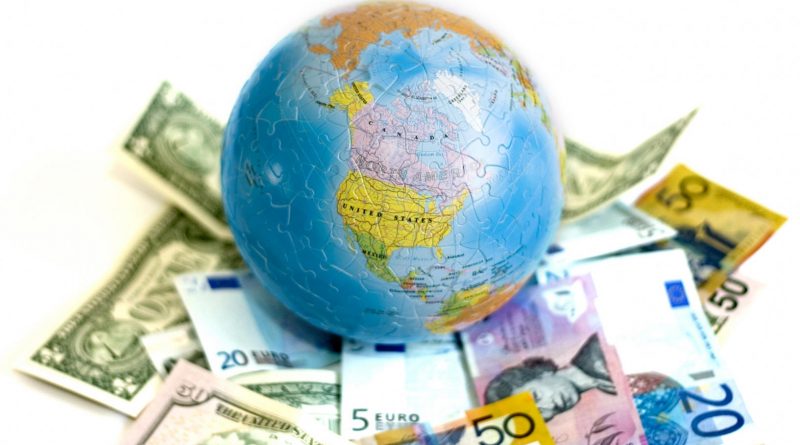Macro Ideas – The four macro heartbeats of global finance in 2018 (Khaleej Times)
When I first started on a Treasury bond futures trading desk in New York fresh out of Wharton, a senior mentor once advised to keep track of the four heartbeats of gold finance in real time. The price of money (interest rates), the price of currency (the US dollar), the price of oil and the price of gold.
The price of money can be expressed by the two year and ten year US Treasury bond yield curve. The two year Treasury note is 1.99% while the ten year Uncle Sam note is 2.55%. The US economy is at or even beyond full employment with the jobless rate at 25 year lows and consumer confidence at 15 year highs. Trump’s tax reform will kick start economic growth and a new capex cycle that could easily mean 3% GDP growth in 2018. There will also be a regime change at the Federal Reserve as Jay Powell becomes chairman of America’s central bank in March.
The Federal Reserve will impact global financial markets in three critical ways. A rise in wage inflation above 3% will cause the Powell Fed to raise rates more than the planned three times in 2018. The Fed is also scheduled to reduce its balance sheet by $470 billion as quantitative tightening accelerates. Powell and Trump’s Treasury Secretary are also both proponents of aggressive bank deregulation on Wall Street. My call? The yield on the two year Treasury note could rise 100 basis points while the yield on the ten year Treasury note rises 50 – 70 basis points. The result? The flattest yield curve in decade. If the Treasury yield curve inverts (short rates are higher than long rates), a US recession could be possible in 2019. This scenario is catastrophic for global equities and risk assets.
The price of currency is another dilemma facing global investors. The US dollar index fell 10% in 2017 as Europe’s GDP growth accelerated, the National Front did not win the French election and China did not have a hard landing, the catalyst for an epic rally in Asian/emerging markets. Yet foreign exchange is all about relative economic growth, relative central bank policies, and relative fund flows. The ECB does not want a surge in the Euro much above 1.20 as the EU is an export colossus. ECB President Draghi is only expected to begin scaling back debt purchases in September and the Italian election could well lead to a leftist, populist Five Star government. In short, King Dollar could well be resurrected in 2018 as the Euro falls to 1.06. Sterling, as always, is a play on Brexit, Westminster politics and the monetary mandarins of Threadneedle Street.
The unrest in Iran, OPEC’s third largest producer, adds an ominous dimension to a geopolitical supply risk premium, elevated due to events in Libya, Nigeria, Iraqi Kurdistan and Venezuela. The Saudi-Russian output pact will continue in 2018 as strong global growth boosts distillate demand. I can envisage Brent trading in a 60 – 70 range. If Iran’s oilfield output is impacted by strikes, the world could well face its biggest supply shock since October 2011, when NATO bombing and a local militia revolt led to the collapse of the Gaddafi regime and the lynching of the “Comrade Colonel”. Brent traded at $128 as Libyan output plunged to near zero.
However, the surge in West Texas above $62 means a rise in US shale rig counts and output. US output could well hit 10 MBD in 2018. Every oil boom creates the seeds of its own destruction, a bitter macro lesson I learnt the hard way in life.
I am impressed that gold has managed to rally to $1325 an ounce despite the outlook for sharply higher US Fed interest rates. Of course, gold has been a disaster as an investment in the past decade, down from its September 2011 high of $1930. So why is Auric above $1300? One, wage inflation risk. Two, geopolitical risk sin the Middle East, notably in Iran and North Korea. Three rising jewelry demand in Asian emerging markets. Four, a delayed reaction to the US dollar index’s 10% fall and Dr. Copper’s 30% rise in 2017. Five, a cheap hedge against an overvalued Wall Street. Six, Brent’s double bagger since its $28 bottom in 2016. Is gold sending us an inflation SOS? Not yet – but if the yellow metal hits $1500 an ounce (it will not in 2018), all bets on inflation are off and the world has changed.
Market View – Data center REIT’s are the hottest global property micro-markets!
I am fascinated by the impact of technology – ride hailing apps, Big Data, driverless cars, smart grids on property markets worldwide. For instance, only 2% of all taxi rides in the Middle East emanate from ride hailing services like Uber and Careem? Dozens of MENA cities do not even have access to such services. Yet I believe on demand mobility will be ubiquitous in a decade even as electric, driverless cars replace the gas guzzlers clunker fleets in our region. Now that Saudi Arabia has doubled petrol prices, who in his right mind will drive across the Los Angles scale sprawl of Riyadh or Jeddah in a Nissan Patrol/Armada or, God forbid, a GM Suburban? What will this mean for land and home prices in the kingdom’s major cities?
Data center real estate in the US, Europe and Asia are of obsessive interest to me, as both an investor and student of global technology trends. Take data center REITs, for instance. Their tenants are the crème de la crème of Silicon Valley, the world’s finest credits. Their complex fit outs mean long life leases linked to inflations. Their fiber optics networks class, the digital backbone of E-commerce, cloud computing, biotech, Big Data analytics, robotics and artificial intelligence. These are the tectonic megatrends that will define the rest of our lives and have a seismic impact on property investing worldwide.
When I addressed a recent investor dinner, a member of the audience asked me if all this was positive for Silicon Oasis. I was truly stunned and a loss for words at his conclusion. I can easily envisage a future where there will be hundreds of server farms in vast data centers in Silicon Oasis, (though Skype/VOIP will remain blocked and even illegal) that will power the Gulf’s transition to the Digital Age. The biggest shopping malls, taxi fleets, banks, insurers, stockbrokers, gold retailers and media networks in the Arab world could all be live and trade online. I can easily envisage a future when the largest, most liquid, most profitable property investment in Dubai is a data center REIT listed on the Dubai Financial Market. Futuristic fantasy? No. A rational extrapolation of embryonic trends in the world around me in Arabia’s ultimate “Smart City”.
As a property investor, I believe four criteria should be non-negotiable when investing. One, it should not be a generic sector with no barriers to entry and thus vulnerable to a new supply glut. This rules out most offices, retail (Amazon is the ultimate Death Star for regional shops, malls and even brands) and homes. Two, liquid REITs are far better investments than illiquid brick and mortar, especially in markets with 4% inflation, 6 – 7% transaction costs and high sovereign risk premiums like the GCC. Three, the best landlords (REITs) are those who have rental pricing power and whose tenants cannot easily move. Four, sectors that are high secular growth oligopolies. Data centers and medical laboratory REIT’s perfectly fit all these criteria, even if these puppies simply do not exist in the Middle East property and stock market. But one day they will. That much, at least, is certain.
My quest is for real estate investment trusts (REIT’s) with intrinsic competitive advantage, ability to acquire mispriced assets, access to cheap financing and power to raise rents/net operating income.
The average property developer is clueless about building state of the art data centers on a global scale. These are hugely expensive, complex construction and fit out projects, with vast cyber security protocols, access to electricity/fiber optics infrastructure. If done right, net operating income for a start of the art data center is one third of its building cost. The result? Oligopolistic industry structure and landlords who print money I can easily model a property micro-market segment that can well deliver 20% compounded annual growth in the next decade.
As I data crunch the numbers, the potential is unreal. As AI powered robotics and driverless cars mean a quantum surge in daily data traffic, possibly as much as 5000 times current usage. The human mind is not hard wired to grasp the implication of exponential growth curves, the logic of phenomena like Moores Law or the Cambridge mathematician Ramanujan’s effort to model infinity. At least, my mind is not. Yet one thing I know. This will be the most fascinating and profitable property investing niche in the next three years. For a property investor, the price of ignorance will be just far too high!
Stock Pick – Are Aerospace’s fallen angels the next market stars?
Aerospace and defense shares were a stellar performer in 2017, led by the spectacular rise in Boeing shares from $156 to $335. Geopolitical crises in the Middle East/North Korea, the Indian-Pakistan subcontinent, Crimea/Ukraine, South China Sea etc. have convinced the US, its NATO allies and countries as diverse as India to Saudi Arabia, Indonesia to Egypt to increase their military budgets. The reduction in tax rates and expansion of the capital expense depreciation allowance to 100% will hugely boost the sector’s free cash flow. Synchronized global economic growth will increase passenger traffic and global aviation. The multi-billion dollar research and development (R&D) under Trumps tax plan will also reduce effective tax plan.
Raytheon was my top pick in this sector, profiled in this column as a hedge against geopolitical risk in the Korean DMZ due to its role as the world’s preeminent vendor of anti-ballistic missiles and defense microelectronics. However, other than Raytheon, I am mostly interested in the Cinderellas/fallen angels of global aerospace. This leads me to United Technologies (UTX) and General Electric (GE), two classic canines of the Dow.
United Technologies is one of the world’s best known conglomerates, thanks to its global franchise in Otis elevators and Pratt and Whitney aircraft engines, though it has divested its Sikorsky helicopter business. The shares had grossly lagged Boeing due to the stock markets concern about the takeover premium the company paid to acquire Rockwell Collins, operating margins for Otis elevators and the scale of the tax payable on its $31 billion in undistributed repatriated earnings. Yet Trump’s tax plan will see the company’s effective tax rate fall by at least 4 to 6 points as it takes advantage of R&D credits and 100% capex depreciation allowances. Now that it can access its global cash hoard, United Technologies can reduce its balance sheet leverage, which will unquestionably boost 2018 earnings and cash flow. Aerospace analysts on Wall Street it is not unrealistic to expect $8.20 in 2019 pro forma EPS. Given the post Rockwell deal will be a unique aerospace beast, I expect United Technologies can trade at a valuation multiple of 20 times earnings or $164 a share. This is a classic high delta put sale candidate on any slip to 124.
General Electric was the ultimate bow wow stocks in the Dow Jones index in 2017 and in fact the entire past decade. Jeff Immelt gutted shareholder value for 15 years, with an imperial CEO’s unique talent for selling great assets at market bottoms and buying garbage assets at market tops. The 50% plunge in the stock price, dividend cut and new CEO John Flannery’s still incoherent vision for the epic restructuring that lies ahead has created a classic “blood on the street” argument that Nathan Mayer Rothschild would have loved. General Electric was leprosy in 2017 and white-hot in the first week of January, rising from its 17.40 bottom to 18.78 now. Has this mismanaged, unloved conglomerate finally made a capitulation bottom? My instincts and corporate math tell me yes I expect Flannery to reinvent General Electric as a global aerospace company and for normalized EPS to be as high as $1.70. General Electric is also one of the Goldman Sachs high growth capex/R&D relative to corporate cash flow from operations basket. Of course, trying to bottom fish a broken stock like GE is like trying to ballet dance on a minefield – never a good idea. I realise that no one on earth, not even the CEO himself, knows what General Electric will look like in 2019. Yet Flannery has invited a Trian partner on his board and got rid of most of the deadbeats. This is a good omen. The GE of the future is an aerospace firm, not a healthcare/wind/energy conglomerate.
GE is not for widows and orphans. GE’s financial leverage is dangerously high at 3.5X earnings. Cash flow and EPS has been slashed by 50%. Flannery has not articulated a credible turnaround vision to Wall Street. GE is leprosy in the industrial sector in its balance sheet and commercial paper borrowings. Caveat emptor!
Textron, the maker of Bell Helicopter and the US Air Force’s scorpion jet, could well be aerospace takeover bait in 2018. The die is cast, the game’s a foot! Note the shares surge from 46 to 58. This spells merger arbs/accumulation to me. My Fox trade déjà vu!
(Khaleej Times)




